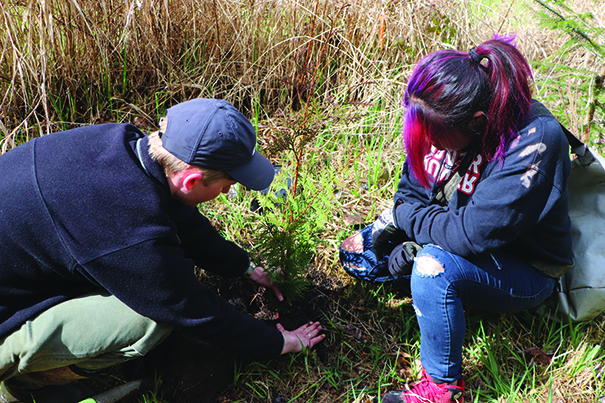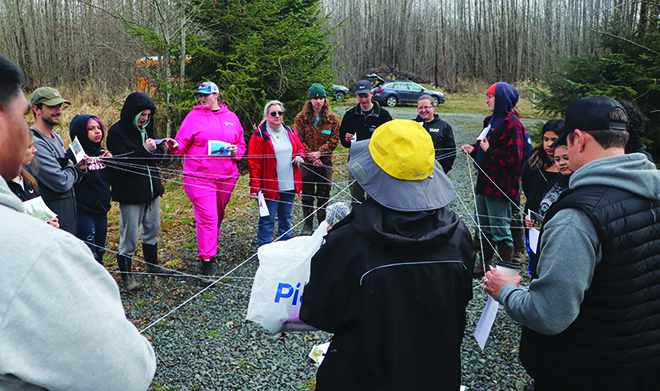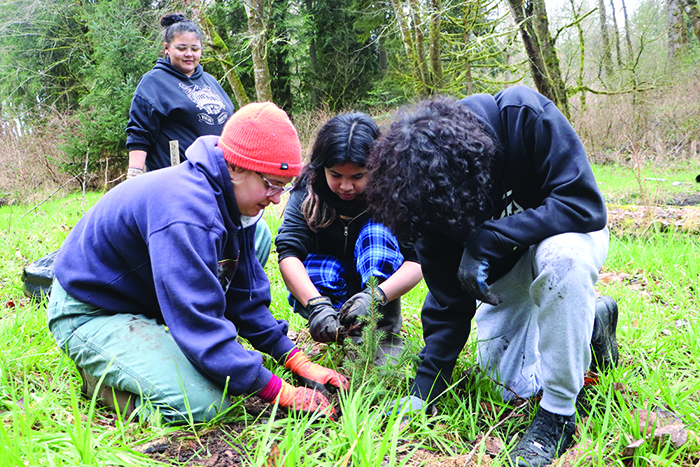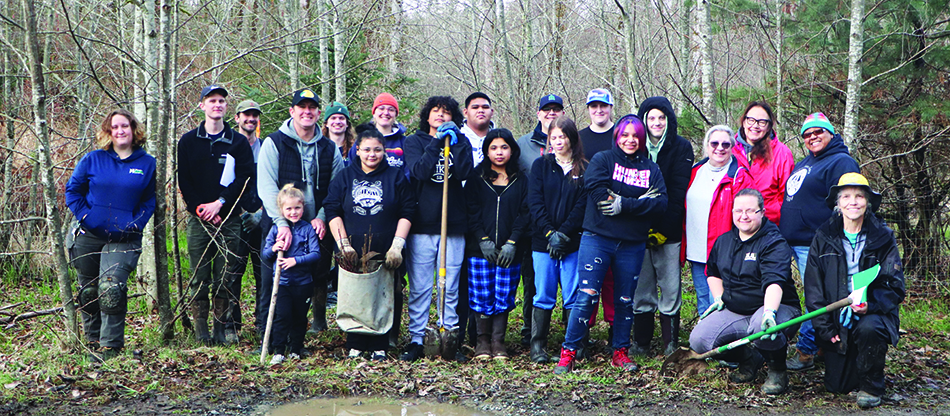
By Shaelyn Smead, Tulalip News
On March 21, Heritage High School students were recruited by the Wetland Program to help plant over 100 trees in Quil Ceda Village (QCV) wetlands to sustain the Coho Creek restoration site. The sunny spring day made perfect weather for the students to take on the cool wetlands. With about ten students and some Heritage staff dressed in boots and carrying their shovels, they were well prepared to get the job done.
Kyliah Elliott and Lacinda Moses were just a few of the students in attendance. The girls explained how they were taking this opportunity to observe what an internship would include with the Wetland Program.
“I came today because I like being outside and wanted to be a part of the tree planting because it’s a part of who we are. I want to intern here and maybe learn more. People are ruining the environment every day, and I hope I can make a difference one day to help fix it,” Lacinda said.

Wetland Program Coordinator Allison Warner’s goal is also to attract more tribal members and Native youth towards environmental work and join different areas of the Natural Resources department. In doing so, she has offered up internship positions to several tribal members already interested in the field and continues to involve Native students in events like tree planting.
“I would love to help educate and support more Native biologists. I think the Indigenous perspective has more layers to it than non-Natives’. We [non-Natives] can do our best to educate ourselves on Native culture and way of life. Still, a Native biologist would have their unique perspective and cultural connection to represent Tribal resources better.”
The Tulalip Wetland Program has conducted efforts to rehabilitate the area since 2016. With over 4000 acres of wetlands making up approximately 1/4 of the reservation, understanding wetlands is critical to how Tulalip lives and thrives. Wetland analysis, preservation, and potential development projects play a significant role in determining what wetlands can succeed with some assistance and provide tribal resources like salmon, deer, berries, cedar, etc., and what wetlands are best to develop for future tribal projects and endeavors.
Allison said significant efforts focused around the QVC wetlands have been primarily due to the destruction caused by the US military during World War II. During that time, the US military occupied the land with hiding military equipment and resources. The heavily forested area made for the perfect escape to blend into and hide from any aerial spy surveillance. Along with that, with its quick access to the freeway, the military could quickly import/export and leave at a moment’s notice.

However, because the area is a wetland, the US military needed to make the land more viable for their efforts to start any building or have access to it. One major course of action was making large ditches that forced all the water from the wetland into one central area. Along with depriving that area of its primary resources, many trees, bushes, and other agricultural species were removed, demolished, and consumed to make the land easier to maneuver around on. Even a railroad was created solely to transport military equipment in and out of the area. Today, a piece of that railroad still exists.
Soon after the war was over and the military departed, the Tribe and the State determined how damaged the land was. Along with destroying the land’s natural resources, items like bunkers and equipment were left behind, and chemical spills and chemically-affected septic tanks were brought to attention. At this point, the US Environmental Protection Agency was brought in to survey the land and create a plan to clean up the ground.
Since then, much progress has been made, and the area is no longer considered a danger. Significant steps like tree planting have been implemented to rehabilitate the wetland. Overall, wetlands play a substantial role in how the environmental pyramid thrives.
Allison explained, “With the area’s connection to Coho Creek and Sturgeon Creek, protecting the stream’s water quality and helping the salmon thrive in this area is essential. The area we are planting trees in is the property’s wettest part and is most suitable to feed the stream. As we’ve seen with our efforts, certain species like beaver, deer, and birds have migrated back to the wetland and are helping sustain the wetland.”
Some trees were reintroduced to the wetland, such as Sitka spruce, paper birch, cedar, red osier dogwood, and alder. Other items like pollinating plants, hooker willow, bitter cherry, shrubs, honeysuckle, black twin berry, and wapato are also being planted. All of these are meant to replicate the environment before US military inhabitance.

So how do trees benefit a stream? Allison described trees as the structure that keeps the bank from eroding. They also provide the organic matter that insects eat, which in turn, other species will eat, and so on. Therefore, trees and shrubs act as the foundation of food webs. Additionally, they provide shade to keep the stream and salmon cool. Ultimately, salmon cannot live in water more than 65 degrees Fahrenheit. So if the water were too high or hotter than necessary, it would affect the oxygen levels of the creek, and salmon won’t exist in this area.
Currently, a small run of salmon occupies the stream, but they hope it can become a more stable place for salmon to spawn and thrive. Planting trees is only the beginning. Tending to the area, monitoring the new trees and plants, and ensuring its survival against invasive species is the focus for the next ten years.
If you would like to volunteer your time and efforts to the wetland projects, please get in touch with Allison Warner at awarner@tulaliptribes-nsn.gov.